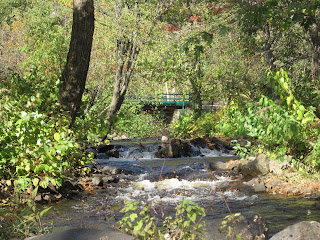The Des Prairies river (Plains river) flows between Montreal and Laval islands. Montreal and Laval islands are the two largest islands of the Hochelaga archipelago (over 200 islands) created by the mixing of two great rivers that are the Ottawa and the St-Lawrence rivers. The western part of the Des Prairies river has honest currents with small stretches of white waters. Someone can do a fair distance upstream with a canoe that has a saddle or strapping gears. Thats what I did today which was september 25th. Canoe landing was possible from Roxboro island in the western part of Montreal Island. To get there take the Boulevard des Sources exit from highway 40 and drive north up to Gouin boulevard. Then turn right on Gouin then left 2-3 streets later on 5e Av. (5th avenue). Go to the end of 5e av. for parking. Parking allowed all day during weekend days but only from 9:00 am to 4:00 pm during week days. Here are some pictures from this canoe day.

Above: Des Prairies river section described in this blog. Color coded map is from canoeing association Fédération Québécoise du Canot-Camping
Above: the entrance of Roxboro island.
Above: you have to cross Roxboro island to reach the Des Prairies river. Portage from start of Roxboro island to the river is maybe 100 to 200 m. Landing of canoe directly on the left of the bridge will bring you to the river but in low water like today I needed to get out of the canoe 2-3 times to get over obstacles. Beware for your white clothes, its muddy. Distance from bridge by canoe around 200 m.
Above: Upstream view of the Des Prairies river from Roxboro island. The Laval side in this area (across) is very residential while the Montreal island side in the Roxboro area (this side) is better conserved. A lot of ducks and geese observed on the Montreal island side. Went canoeing upstream. First stop was at the ridge where there is a bit of white water (at the end of the picture).
Above: The ridge goes from the Montreal island side to almost the other side (in Laval). White water at the end of the ridge towards Laval island is perfect for someone that wants to get familiar with wave surfing.
Above: Downstream view from the ridge. Mont-Royal in sight. Downtown Montreal is behind Mont-Royal in this picture.
Above: The Des Prairies river waterway passes on the right side of the ridge when coming upstream.
Above: To get more upstream on the river my paddling skills dont allow me to use the waterway like these guys (I am challenging anyone to try). Crossing the ridge with my feet in the water fairly easy. Paddling on the left side after crossing the ridge is much more easy to get more upstream.
Above: Train bridge crossing from Montreal island to Bigras island. This bridge is around 1 km upstream the ridge.
Above: Train bridge crossing to Bigras island again.
Above: Bridge pillars always a nice spot to rest when going upstream. Car bridge leading to Verte island (Green island). Went upstream toward that bridge and further up.
Above: Several houses around the islands in this area have their waterfront like fortress to protect their houses from spring high waters.
Above: The Des Prairies river is probably the biggest hydroplane hub in Quebec. When hanging on this river, you are almost always sure to see one either landing, taking off or being parked. This parked one was observed between Bizard and Bigras island. Thats the furthest upstream I went on the river.




















































